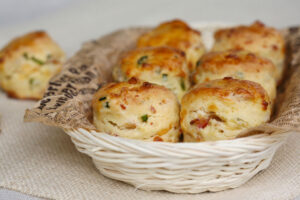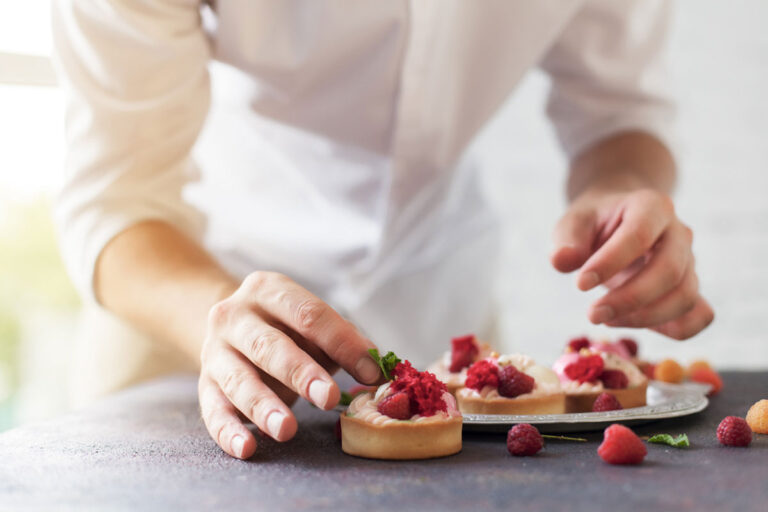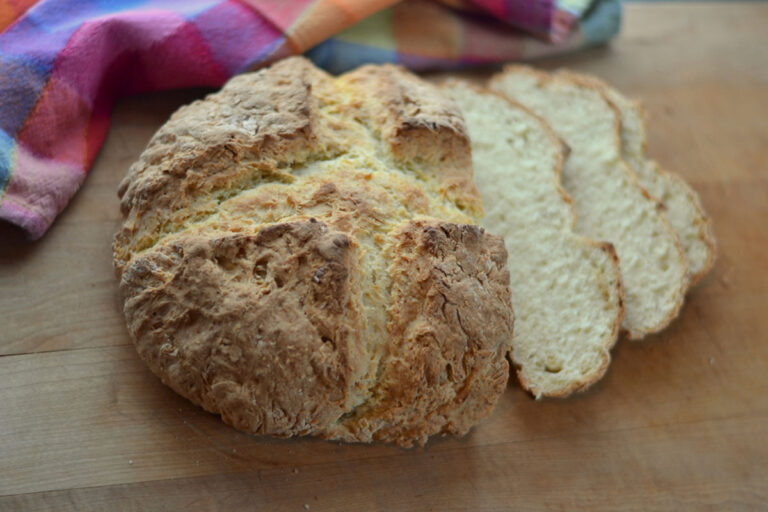The Origins of the Irish Scone
Scones are one of the most beloved baked goods in Ireland, rooted in both tradition and daily life. Their humble beginnings trace back to rural Irish kitchens, where simple ingredients like flour, butter, and buttermilk were transformed into warm, flaky scones. These early versions were made over an open fire, often on a griddle, known as a “girdle” or “bakestone,” before ovens became common in homes.
The word “scone” is believed to have originated from the Gaelic term sgonn, meaning a shapeless mass or large mouthful, indicating their rustic, handmade nature. Unlike their English counterparts, which are often lighter and served with clotted cream and jam, Irish scones tend to be heartier, made to sustain families during long working days.
In Ireland, scones have evolved over centuries but remain a staple of hospitality. Their simplicity and versatility make them perfect for any occasion—whether breakfast, an afternoon snack, or even a casual dessert.
Essential Ingredients for the Perfect Irish Scone
The magic of Irish scones lies in their simplicity, with just a few high-quality ingredients needed to create these traditional treats. While the recipe may seem straightforward, the freshness and quality of each ingredient play a significant role in achieving the perfect texture and flavor.
1. Flour:
The foundation of any scone is the flour. In Ireland, plain white flour is most commonly used, giving scones a soft and tender crumb. Some bakers might add a bit of wholemeal flour for a heartier, more rustic version, but classic Irish scones typically stick to white flour for their lightness.
2. Butter:
Irish butter, known for its rich, creamy texture and golden color, is the unsung hero of the Irish scone. Whether salted or unsalted, the butter should always be cold and cubed before being rubbed into the flour. This creates pockets of fat, which melt during baking, producing the signature flaky layers of a well-made scone.
3. Sugar:
While Irish scones aren’t overly sweet, a touch of sugar is added to balance the richness of the butter. Traditional recipes use only a small amount, keeping the flavor mild enough to be complemented by jam or butter once baked.
4. Baking Powder:
To give the scones their rise and slight fluffiness, baking powder is a must. It acts as a leavening agent, helping the dough rise quickly in the oven and creating the characteristic airy texture.
5. Buttermilk:
The key to Irish scones’ moist, tender crumb is buttermilk. Its slight tang also adds a depth of flavor that pairs beautifully with the richness of the butter. Buttermilk reacts with the baking powder, providing lift and ensuring a soft interior with a golden, crisp exterior.
6. Optional Add-ins:
While traditional Irish scones are simple, modern variations might include raisins, currants, or even grated cheese and herbs. However, the purest form often sticks to the basics, relying on the high quality of each ingredient to shine through.
Mastering the Technique – Mixing, Shaping, and Baking
While the ingredients for Irish scones may be simple, the techniques behind making them can make all the difference. The balance between light, airy texture and a golden crust comes down to how the dough is handled and baked.
1. Keep Ingredients Cold
One of the golden rules for making perfect scones is to keep the butter and buttermilk as cold as possible. Cold butter is essential for creating those flaky layers. When the butter melts in the oven, it leaves behind pockets of air, giving the scones their light and fluffy texture. To ensure this happens, cube the butter and chill it before rubbing it into the flour.
2. Rub in the Butter
Using your fingertips or a pastry cutter, rub the cold butter into the flour until the mixture resembles fine breadcrumbs. Be gentle, as overmixing will result in tougher scones. The goal is to coat the flour in small pieces of butter, which will create a flakier, more tender scone.
3. Add the Buttermilk Gently
Once the butter is incorporated, slowly pour in the buttermilk. It’s important to mix gently and not overwork the dough at this stage. Overmixing can develop the gluten in the flour, resulting in a denser scone. Use a light hand and a wooden spoon to bring the dough together. If necessary, add a little more buttermilk, but be careful not to make the dough too wet.
4. Roll and Cut
Turn the dough out onto a lightly floured surface and gently pat or roll it out to about 1-inch thick. Avoid using a rolling pin aggressively, as pressing too hard will compress the dough and result in less rise. When cutting out your scones, use a sharp biscuit cutter and press straight down without twisting. Twisting seals the edges and prevents the scones from rising properly. Gently reshape any leftover dough for additional scones, but keep handling to a minimum.
5. Bake at High Heat
Preheat your oven to a high temperature, typically around 200°C (400°F). The scones need that quick burst of heat to rise properly and achieve a crisp, golden top. Place the scones on a lined baking sheet, close together but not touching, as this helps them rise upwards rather than spread. For a shiny, golden crust, brush the tops with a little milk or egg wash before baking.
6. Timing is Key
Bake the scones for about 12–15 minutes, or until they’ve risen and are a rich golden brown. Keep an eye on them, as overbaking can dry them out. Once baked, transfer them to a wire rack to cool slightly before serving.
Mastering these techniques is key to creating scones with the perfect balance of fluffiness and crispness.
IRISH CHEDDAR AND BACON SCONES
Description: These savory scones blend sharp Irish cheddar and crispy bacon, creating a delightful combination perfect for breakfast or as...
View RecipeIRISH SODA BREAD SCONES
Description: Irish Soda Bread Scones are a delightful twist on traditional Irish soda bread. These scones are tender, slightly sweet,...
View RecipeSweet and Savory Variations – Creative Twists on Classic Irish Scones
While the traditional Irish scone, simple and lightly sweetened, is an enduring favorite, there’s no reason to stop there! Scones are wonderfully versatile, lending themselves to both sweet and savory variations.
1. Sweet Variations:
- Fruit Scones:
Arguably the most popular variation, fruit scones are a delightful blend of tart and sweet. Currants, raisins, or sultanas are commonly used, adding bursts of flavor. For a zesty twist, you can mix in orange or lemon zest to balance the sweetness of the dried fruit. These scones are perfect for breakfast or an afternoon tea. - Berry Scones:
Fresh berries, such as raspberries, blueberries, or blackberries, make for juicy, summery scones. Fold them gently into the dough to prevent them from breaking apart. A dusting of sugar on top before baking can add an extra crunch and a sweet finish. - Chocolate Chip Scones:
For chocolate lovers, adding chocolate chips is a fun way to enjoy a sweeter version of scones. Dark or milk chocolate chips, or even chunks of white chocolate, melt deliciously into the dough. Serve these with a dollop of whipped cream for an indulgent treat. - Spiced Scones:
Cinnamon, nutmeg, or mixed spice can be added to the scone dough for a warming, fragrant touch. Pairing these spices with dried fruits like apricots or figs enhances the depth of flavor, making them a perfect choice for cozy afternoons by the fire.
2. Savory Variations:
- Cheddar and Chive Scones:
Savory scones are an ideal accompaniment to soups, salads, or stews. Sharp Irish cheddar pairs beautifully with fresh chives, giving the scones a savory, aromatic flavor. These scones are also great with a dollop of butter while still warm from the oven. - Bacon and Cheese Scones:
For a heartier option, diced crispy bacon and a mix of cheeses such as Irish cheddar and Parmesan create a rich, savory scone. Perfect for brunch, these scones also work well on their own or as part of a larger breakfast spread. - Herb Scones:
Fresh herbs like rosemary, thyme, or parsley can elevate the flavor of savory scones. Herb scones can be served with a selection of cheeses or as a side to a hearty meal. Adding a touch of black pepper or mustard powder can give an extra depth of flavor. - Guinness and Onion Scones:
For an even more Irish twist, try incorporating caramelized onions and a splash of Guinness into the scone dough. The stout adds a malty richness, while the onions bring a sweet-savory balance that complements any Irish meal.
3. Seasonal and Creative Twists:
- Pumpkin Scones:
Incorporating seasonal ingredients like pumpkin or squash into the scone mix offers a moist and subtly sweet variation. Adding warming spices like cinnamon and cloves gives these scones an autumnal flavor, perfect for enjoying with a cup of tea on chilly days. - Seaweed and Sea Salt Scones:
For a truly Irish coastal flavor, finely chopped seaweed and a sprinkle of sea salt can be incorporated into savory scones. The seaweed adds a slightly briny taste, reminiscent of the Irish shoreline, making these scones a unique and flavorful option. - Honey and Oat Scones:
Oats and honey create a rustic, hearty scone that’s packed with texture. The natural sweetness of honey pairs well with the nuttiness of oats, offering a wholesome option that’s great for breakfast or as a midday snack.
4. Tips for Flavor Pairings:
- Sweet scones pair perfectly with a variety of spreads such as clotted cream, jam, lemon curd, or even Nutella.
- Savory scones can be served with butter, chutneys, or alongside soups and stews.
- For a balanced flavor profile, you can experiment by combining both sweet and savory elements—such as adding a hint of cinnamon to cheese scones or topping fruit scones with herb butter.
The Perfect Accompaniments and Serving Suggestions
Now that we’ve covered the history, essential ingredients, techniques, and creative variations of Irish scones, it’s time to focus on how to serve and enjoy them. Scones are a versatile treat that can be tailored to different meals, occasions, and tastes. Let us now explore the perfect accompaniments and serving suggestions to elevate your scone experience.
1. Sweet Accompaniments:
- Jam and Clotted Cream:
The most classic way to enjoy sweet scones is with a generous dollop of fruity jam and clotted cream. Traditionally paired with plain or fruit scones, the combination of smooth, rich cream and sweet, tart jam creates a perfect balance of textures and flavors. Raspberry, strawberry, or blackberry jams are traditional favorites, but apricot or fig preserves can offer a unique twist. - Butter and Honey:
A simple yet delicious option, spreading a pat of Irish butter over a warm scone allows the flavors to meld perfectly. Drizzling honey over the butter adds a touch of sweetness, especially for scones flavored with cinnamon or oats. The slight saltiness of good-quality butter contrasts beautifully with the natural sweetness of honey. - Lemon Curd:
For a zesty alternative to jam, lemon curd offers a bright, tangy flavor that pairs wonderfully with plain or berry scones. The creamy texture and tartness of the curd provide a refreshing contrast, making it a favorite for those who love citrus flavors. - Whipped Cream and Fresh Berries:
For a more indulgent take, freshly whipped cream and seasonal berries are a fantastic way to top off your scones. Whether paired with strawberry scones or served on the side of a sweet variation like chocolate chip or spiced scones, fresh fruit adds both flavor and a visual appeal.
2. Savory Accompaniments:
- Cheese and Butter:
Savory scones, especially those flavored with cheese or herbs, are delicious when paired with a soft cheese spread or a slice of sharp Irish cheddar. Serve these with a touch of butter or alongside a selection of pickles for a rustic, hearty snack. - Chutneys or Relishes:
A well-chosen chutney, such as caramelized onion or tomato relish, can be a superb match for savory scones. The tangy, sweet-spicy flavor of chutney complements the richness of scones made with bacon, cheese, or herbs, offering an explosion of contrasting tastes. - Smoked Salmon and Cream Cheese:
For a more luxurious option, smoked salmon paired with a dollop of cream cheese on a savory scone is an elegant and flavorful combination. The soft texture and briny flavor of the salmon enhance the buttery, flaky scone, making this a perfect brunch option.
3. Beverages to Pair with Scones:
- Tea:
No Irish scone experience would be complete without a strong cup of tea. Traditional Irish breakfast tea or a bold black tea like Earl Grey complements both sweet and savory scones. The tannins in the tea cut through the richness of the butter and cream, providing a refreshing balance. - Coffee:
A freshly brewed cup of coffee is also an excellent choice to accompany scones, especially the sweeter variations. The deep, roasted flavors of the coffee pair well with the buttery, sweet elements of a fruit or chocolate scone. - Hot Chocolate:
For a comforting and indulgent treat, pair sweet scones with hot chocolate. The rich, velvety texture of hot chocolate enhances the flavors of chocolate chip or berry scones, making this combination perfect for cold winter afternoons. - Guinness or Irish Stout:
For a savory scone served during lunch or dinner, pairing it with a glass of Irish stout like Guinness can elevate the experience. The malty, roasted flavors of the stout complement the richness of cheese or bacon scones, creating a satisfying and robust meal.
4. When to Serve Scones:
- Afternoon Tea:
Scones are traditionally served as part of an afternoon tea spread, where they are enjoyed alongside finger sandwiches, cakes, and pastries. This is the ideal setting for serving both sweet and savory variations of scones, along with an assortment of jams, creams, and butter. The relaxed yet elegant atmosphere of afternoon tea allows guests to savor each bite and pair their scones with various toppings. - Brunch or Breakfast:
Scones are also a fantastic addition to a brunch menu. Sweet scones pair well with fruit salads, yogurt, and fresh juice, while savory scones can accompany eggs, bacon, and other traditional breakfast dishes. The versatility of scones makes them a delightful option for a range of morning meals. - Picnics and Outdoor Events:
Thanks to their portability, scones make for a great addition to picnics or outdoor gatherings. Sweet scones can be enjoyed with fresh fruit, while savory scones pair well with charcuterie boards or grilled meats. They’re easy to pack and even easier to share.
5. Tips for Storing and Reheating Scones:
- Storing:
Scones are best enjoyed fresh, but if you have leftovers, store them in an airtight container at room temperature for up to two days. For longer storage, scones can be frozen. Wrap each scone in plastic wrap and place them in a freezer-safe bag or container for up to three months. - Reheating:
To bring scones back to their original glory, gently reheat them in the oven at a low temperature (around 150°C/300°F) for 5-7 minutes. This method will help maintain their light, flaky texture. Avoid microwaving scones, as this can make them dense and chewy.
Whether you prefer classic butter and jam or more creative pairings like smoked salmon and cream cheese, the possibilities are endless. With the right beverage and setting, scones can be the highlight of any meal or gathering, from afternoon tea to casual picnics.









